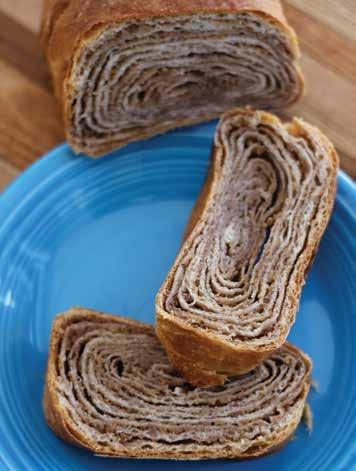
3 minute read
Preserving Potica For the Next Generation
by Melissa Maki
The approaching Easter holiday brings to mind an amalgam of secular, religious, and ethnic traditions. For me, potica, a delectable rolled pastry filled with walnut-honey paste, is chief among them.

Potica (pronounced po-teet-sa) has Eastern European, and particularly Slavic, roots. Those who understand the care that goes into making potica know that when it is served, it is to be savored.
I’ve always been fascinated by ethnic food traditions, but this one is particularly dear to my heart. I grew up on the Iron Range, where one’s ethnic heritage is still a point of personal pride. For those with Slavic heritage, potica is not only a delicacy; it’s an integral piece of culture from the Old World we’re trying to preserve.
It’s often reserved for special occasions such as weddings and holidays. Growing up in the Catholic tradition, potica was always a part of the food basket we would have blessed by the priest to eat along with ham, boiled eggs, and oranges on Easter morning.
For years, my Slovenian grandmother has been carrying on the tradition of making potica for our family. Now, my mother has begun to take on the task. It’s a critical skill to pass on; everyone in my family would agree that it’s not really a celebration if the potica is missing.
There are a number of potica variations. All begin with yeasty sweet dough, but the dough’s texture varies — as does the filling. Walnut filling is the standard for potica on the Iron Range, but there are many other varieties.
The dough is stretched over a large floured bed sheet. The skill and dexterity with which my grandmother rolls out and stretches the potica dough is astounding. It’s as if she’s channeling an ancient cultural memory. I’ve taken a couple of lessons from her but it’s still daunting.
Making potica is an elaborate, all-day process, but since it is one of the last remnants of my Slovenian heritage, I’m committed to learning and carrying on this delicious tradition. A version of this article previously appeared in Honest Cooking
Jean Korsman’s Slovenian Walnut Potica
Yeast Mixture
5 teaspoons dry yeast (or 2 packets quick rise yeast)
1 tablespoon sugar
1/2 cup warm water
In a 1 cup measuring cup, dissolve yeast in warm water. Add sugar, stir and let bubbles to top.
Dough Mixture
1 ½ cup scalded milk (1 minute in microwave — can use half canned milk or halfand-half cream)
½ cup sugar
1 teaspoon salt
1 stick margarine
2 large beaten eggs
6 ½ to 7 cups flour (I use Gold Medal regular)
Scald milk and margarine in microwave for 1 minute. Add sugar, salt, eggs, and yeast mixture. Stir and add 6 cups flour, gradually add more flour until dough is no longer sticky.
Knead by hand on floured board for about 20 minutes until smooth. You can also knead in a standard mixer with the dough hook (I do half with dough hook at a time, and then knead all for several minutes to combine).
Place in well-greased large bowl, cover and let rise in warm place or put bowl in hot tap water bath, changing water frequently to keep hot (no kneading after dough is risen to top). Let rise about 2 hours.
Line three pans with parchment paper. (I make three strips using 14-inch pans out of one batch, as my table is 42 inches.) Spray paper with cooking spray.
Filling
6 cups ground walnuts (about 1 ½ lbs.)
1 cup white sugar
1 cup brown sugar
1 teaspoon cinnamon
3 large eggs beaten with 1 teaspoon almond flavoring
1 cup scalded cream or canned milk with 1 stick real butter melted in, and ½ cup honey
Add hot liquid to ground walnuts that have been mixed with sugars and cinnamon. Stir well, add eggs.
Carefully dump dough onto table that has been covered with a twin sheet or tablecloth and lightly floured. Start by rolling dough out with floured rolling pin to a rectangle about 2 by 3 feet. Then stretch dough to 42 by 60 inches, or to your table size. Cut off any thicker edges.
Drop filling by large spoonfuls over two-thirds of the dough (spread filling with hands, it’s easiest and most uniform). Spread evenly to edges. Pick up short edge of cloth and gently roll over and over itself.
Cut into pan-size strips and patch with leftover thin dough or cut with a small plate and pinch ends shut. Place in prepared pans and prick with cake tester (or turkey pin) to prevent air bubbles. Cover and let rise about 40 minutes.
Preheat oven to 325° F or 350° F depending on oven. Bake 35 to 45 minutes until golden brown. (I do mine at 340° F for about 35 minutes). Remove from oven and let cool in pans for 20 minutes.
Carefully dump out in hand, remove paper, and set on a cooling rack. Cover with a cotton cloth and cool. Eat fresh or freeze immediately (I wrap mine in plastic wrap and then freezer foil). Freezes well for up to six months.












